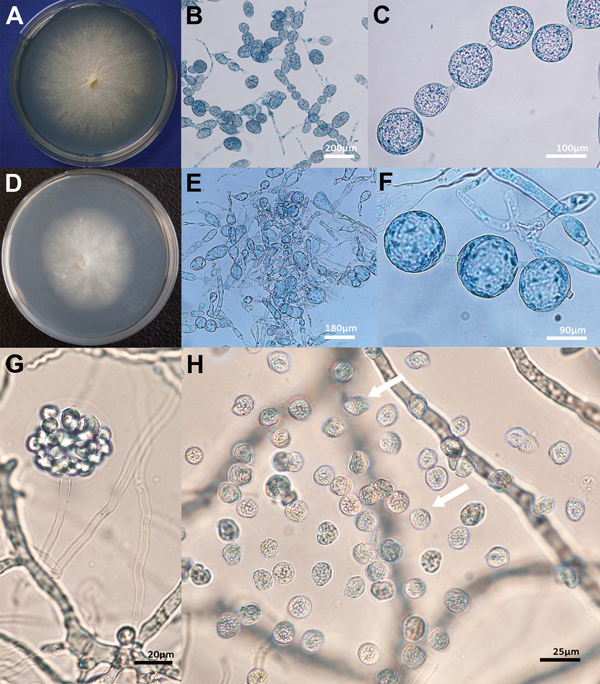Volume 21, Number 2—February 2015
Dispatch
Lagenidium giganteum Pathogenicity in Mammals
Figure 5

Figure 5. Morphologic features of isolates of Lagenidium giganteum mosquito control agent and L. giganteum mold from mammals. Panel A shows henotypic features in culture of the mammalian pathogen (ATCCMYA-4933, type strain) and panel D shows the biological control (ATCC 36492). The development of spherical and ovoid 40- to 170-μm swelling segments (panels B, C, E, F) was the main feature of both mammalian and biocontrol strains. Panel G shows A tubular body developed from an unseen segmented sporangium form a vesicle enclosing numerous zoospores in a mammalian L. giganteum strain. The kidney-shaped zoospores before release (G) and after release (H, arrows) agree with those in the original description of L. giganteum by Couch (10). ATCC, American Type Culture Collection.
References
- De Cock AW, Mendoza L, Padhye AA, Ajello L, Kaufman L. Pythium insidiosum sp. nov., the etiologic agent of pythiosis. J Clin Microbiol. 1987;25:344–9 .PubMedGoogle Scholar
- Gaastra W, Lipman LJ, De Cock AW, Exel TK, Pegge RB, Scheurwater J, Pythium insidiosum: an overview. Vet Microbiol. 2010;146:1–16. DOIPubMedGoogle Scholar
- Grooters AM. Pythiosis, lagenidiosis, and zygomycosis in small animals. Vet Clin North Am Small Anim Pract. 2003;33:695–720. DOIPubMedGoogle Scholar
- Grooters AM, Hodgin EC, Bauer RW, Detrisac CJ, Znajda NR, Thomas RC. Clinicopathologic findings associated with Lagenidium sp. infection in 6 dogs: initial description of an emerging oomycosis. J Vet Intern Med. 2003;17:637–46. DOIPubMedGoogle Scholar
- Mendoza L, Vilela R. The mammalian pathogenic oomycetes. Curr Fungal Infect Rep. 2013;7:198–208.
- Reinprayoon U, Permpalung N, Kasetsuwan N, Plongla R, Mendoza L, Chindamporn A. Lagenidium sp. ocular infection mimicking ocular pythiosis. J Clin Microbiol. 2013;51:2778–80 and. DOIPubMedGoogle Scholar
- Grooters AM, Proia LA, Sutton D, Hodgin EC. Characterization of a previously undescribed Lagenidium pathogen associated with soft tissue infection: initial description of a new human oomycosis [abstract]. Focus on Fungal Infections 14. 2004 Mar 24–26; New Orleans, Louisiana, USA. p. 174.
- Schenk A. Algologische mittheilungen. Verhandl Phys Med Gessell Würzburg. 1859;9:12–31.
- Karling JS. Predominantly holocarpic and eucarpic simple biflagellate phycomycetes. 2nd ed. Vaduz (Germany): J. Cramer; 1981. p. 89–154.
- Couch JN. A new saprophytic species of Lagenidium, with notes and other forms. Mycologia. 1935;27:376–87. DOIGoogle Scholar
- Couch JN, Roney SV. Sexual reproduction in Lagenidium giganteum. Mycologia. 1973;65:250–2. DOIGoogle Scholar
- Kerwin JL, Washino RK. Field evaluation of Lagenidium giganteum (Oomycetes: Lagenidiales) and description of a natural epizootic involving a new isolate of the fungus. J Med Entomol. 1988;25:452–60 .PubMedGoogle Scholar
- Teng H-J, Lu L-C, Wu Y-L, Fang J-G. Evaluation of various control agents against mosquito larvae in rice paddies in Taiwan. J Vector Ecol. 2005;30:126–32 .PubMedGoogle Scholar
- Kerwin JL, Washino RK. Ground and aerial application of the sexual stage of Lagenidium giganteum for control of mosquitoes with rice culture in the central valley of California. J Am Mosq Control Assoc. 1987;3:59–64 .PubMedGoogle Scholar
- Kerwin JL, Dritz DA, Washino RK. Confirmation of the safety of Lagenidium giganteum (Oomycetes: Lagenidiales) to mammals. J Econ Entomol. 1990;83:374–6 .PubMedGoogle Scholar
- Lévesque CA, De Cock AW. Molecular phylogeny and taxonomy of the genus Pythium. Mycol Res. 2004;108:1363–83. DOIPubMedGoogle Scholar
- Rogers-Talbert R. The fungus Lagenidium callinectes Couch (1942) on eggs of the blue crab in Chesapeake Bay. Biol Bull. 1948;95:214–28. DOIPubMedGoogle Scholar
- Jones KE, Patel NG, Levy MA, Storeygard A, Balk D, Gittleman JL, Global trends in emerging infectious diseases. Nature. 2008;451:990–3. DOIPubMedGoogle Scholar
- Morens DM, Fauci AS. Emerging infectious diseases: threats to human health and global stability. PLoS Pathog. 2013;9:e1003467. DOIPubMedGoogle Scholar
- Waterfield NR, Wren BW, French-Constant RH. Invertebrates as a source of emerging human pathogens. Nat Rev Microbiol. 2004;2:833–41. DOIPubMedGoogle Scholar
- Jiang RHY, Tyler BM. Mechanisms and evolution of virulence in oomycetes. Annu Rev Phytopathol. 2012;50:295–318. DOIPubMedGoogle Scholar
- Seidl MF, Van den Ackerveken G, Govers F, Snel B. Reconstruction of oomycetes genome evolution identities differences in evolutionary trajectories leading to present-day large gene families. Genome Biol Evol. 2012;4:199–211. DOIPubMedGoogle Scholar
- Richards TA, Soanes DM, Jones MDM, Vasieva O, Leonard G, Paszkiewicz K, Horizontal gene transfer facilitated the evolution of plant parasitic mechanisms in the oomycetes. Proc Natl Acad Sci U S A. 2011;108:15258–63. DOIPubMedGoogle Scholar
- Ellison CE, Hall C, Kowbel D, Welch J, Brem RB, Glass NL, Population genomics and local adaptation in wild isolates of a model microbial eukaryote. Proc Natl Acad Sci U S A. 2011;108:2831–6. DOIPubMedGoogle Scholar
- Quiroz Velasquez PF, Abiff SK, Fins KC, Conway QB, Salazar NC, Delgado AP, Transcriptome analysis of the entomopathogenic oomycete Lagenidium giganteum reveals putative virulence factors. Appl Environ Microbiol. 2014;80:6427–36. DOIPubMedGoogle Scholar
1These authors contributed equally to this article.